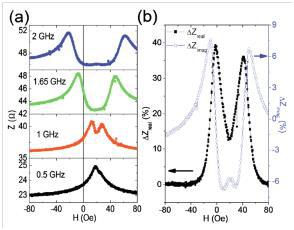People involved: C. Garcia and L. Lizardi.
The magnetoimpedance (MI) phenomenon has become a significant area of research due to the current development in the applications in magnetic sensor technology and the uses of ‘composites” as smart sensors [1]. Various soft magnetic materials such as amorphous with cylindrical geometry, ribbons and nanocrystalline films show large changes in the impedance at high frequency, typically in the range of 50-100%, under the application of DC magnetic fields on the order of few hundreds of A/m, making MI elements very attractive for low field detection being currently used in the automotive and communications sensor industry.
The MI characteristics depending on the dc magnetization process are essentially nonlinear around the zero field point, which makes a straightforward analysis and derivation of an appropriate signal difficult. In samples with a magnetic anisotropy transverse to the applied field, the GMI has either a maximum at zero field or two symmetrical sharp peaks at a field near the anisotropy field. Such nonlinear characteristics are disadvantageous for sensor applications near zero field. Linearization is generally performed by applying a dc bias field to the sensing element to obtain asymmetrical characteristics, but this adds to the complexity of the device and it is disadvantageous for many practical applications, where, for example, low energy consumption is required or in smart sensory composite [2] with remote interrogation, so methods to establish an asymmetrical MI (AMI) response are desirable to improve linearity and reduce the required dc bias. Establishing asymmetrical magnetic configuration helps to improve linearity and reduce the needed DC bias. It has been shown [3, 4] that the position of asymmetrical magnetoimpedance peaks can be tunned by using ferromagnetic (FM)/ antiferromagnetic (AFM) thin films whose magnetic anisotropy is modified by an exchange bias field. The MI can be further shifted to higher magnetic field as the probe frequency increases. Thus, linear MI behaviour can be tune around zero external field by changing the current frequency without the need for external biasing fields or additional coils. Our objective is to optimize the GMI response and minimize the size to reduce even further the power consumption.
Theoretical approach through the classical expression of the impedance of planar magnetic conductor, modeled with a modified Stoner-Wohlfarth energy density, which takes into account the unidirectional anisotropy present in the system.


[1] M. Knobel, M. Vázquez, L. Kraus, in Handbook of Magnetic Materials, Elsevier Science, Amsterdam,. Vol. 15, Chap. 5. (2003).
[2] D.P. Makhnovskiy, L.V. Panina, C. Garcia, A.P. Zhukov, J. Gonzalez, Phys. Rev. B 74, 064205 (2006)
[3] C. Garcia, P. Vargas, J. M. Florez, C. A. Ross, Appl. Phys. Lett. 96, 23 (2010)
[4] C. Garcia, P. Vargas, J. M. Florez, C. A. Ross, J. Appl. Phys. 109, 07D735 (2011)